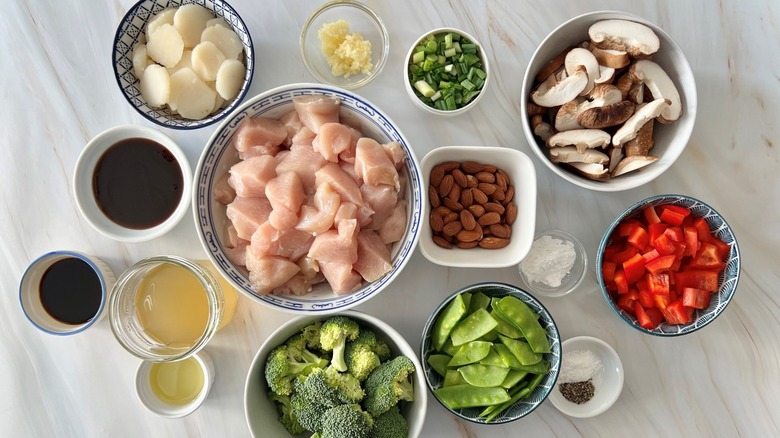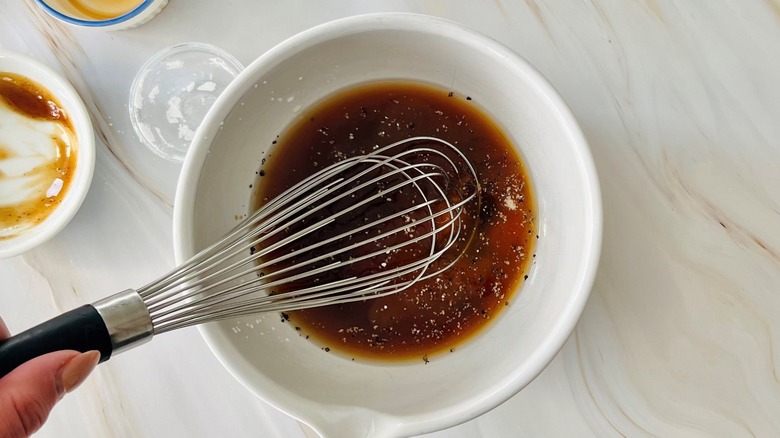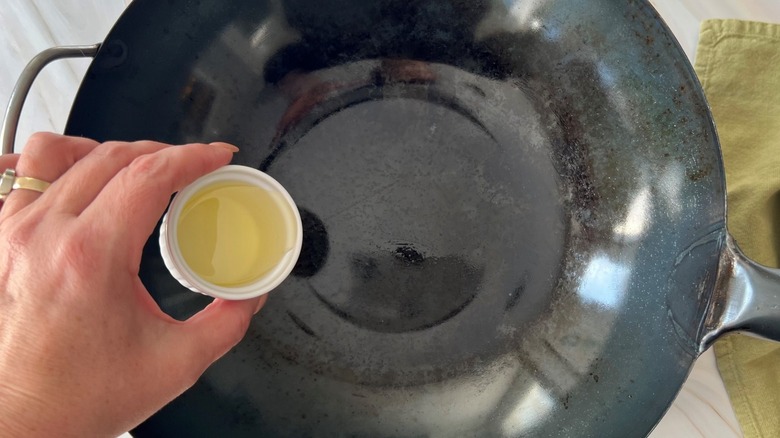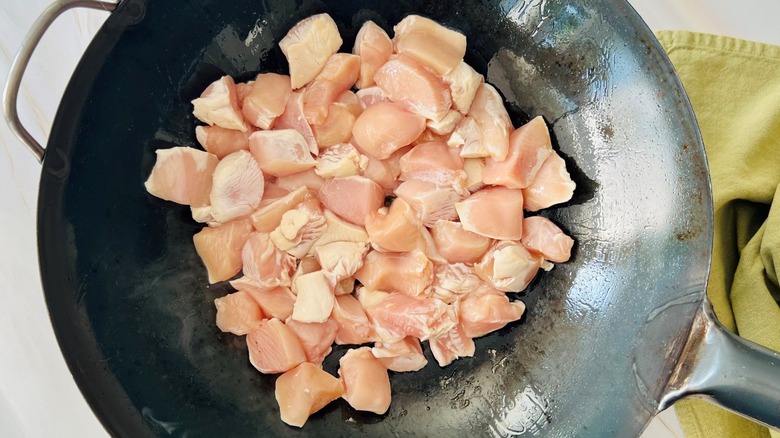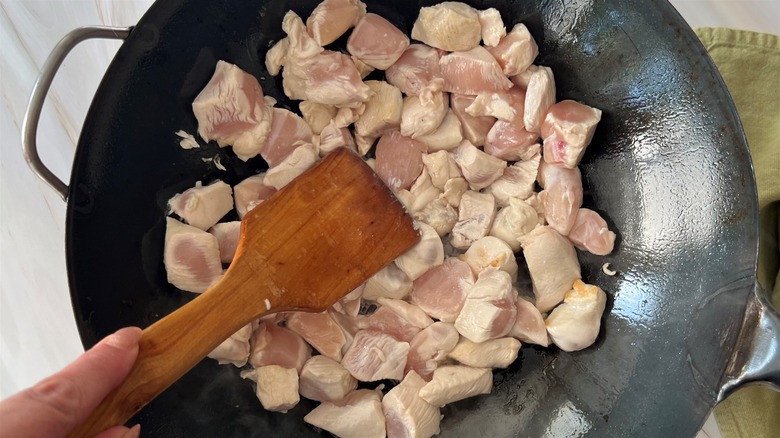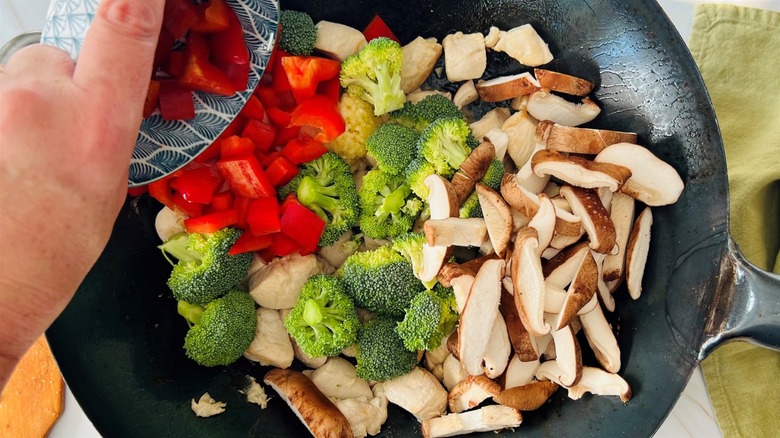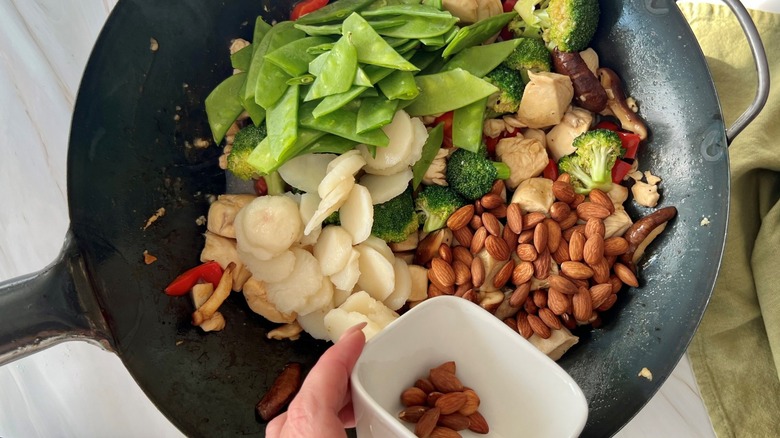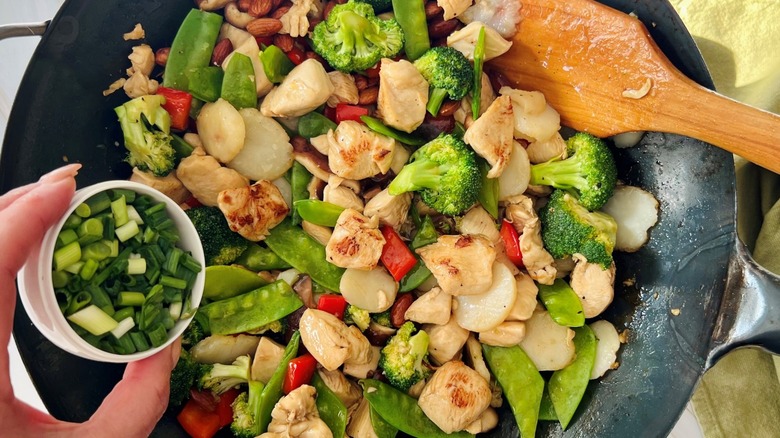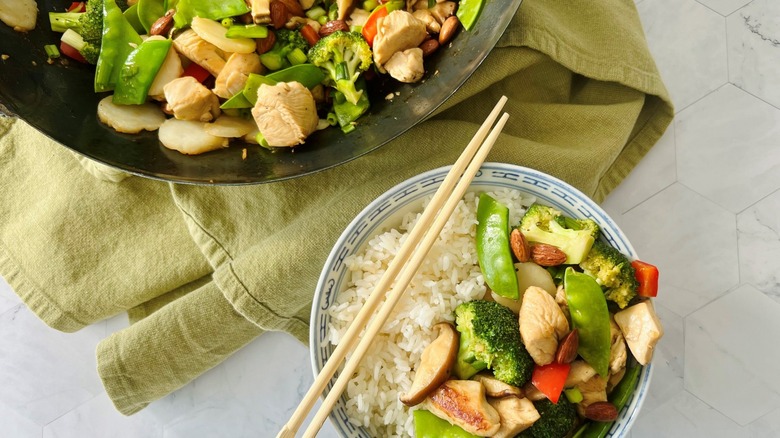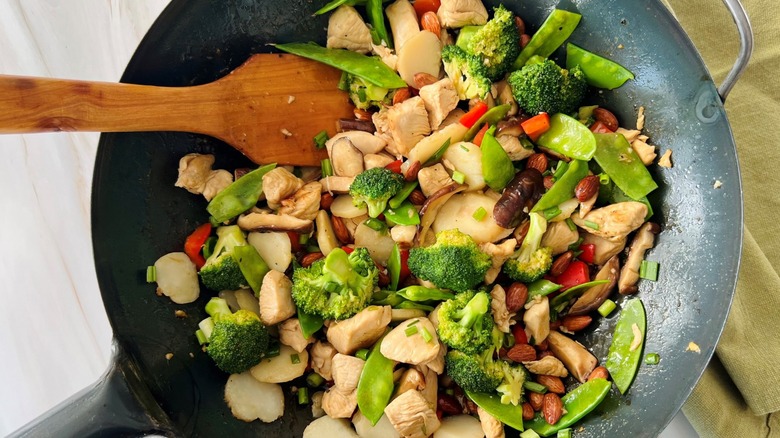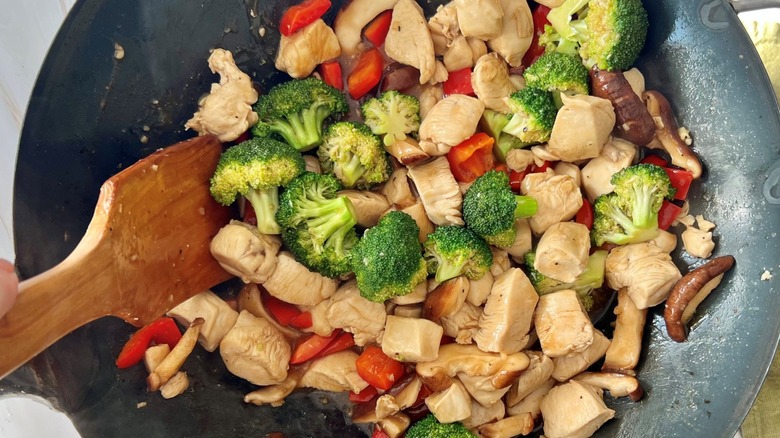Chicken Almond Gai Ding Recipe
There's just something about a stir-fry. In contrast to simpler meals that contain one protein, one starch, and one veggie, stir-fries are a party in your mouth, typically containing an array of colorful veggies and aromatics in addition to proteins like meat, tofu, fish, and even nuts. It's hard to stay bored when you're eating stir-fry!
This particular dish by recipe developer Julianne De Witt is perfect for people who love chicken and like their meals to have a little crunch. "We have a family tradition of ordering Chinese food every Christmas Eve, and chicken almond gai ding is always a favorite," De Witt explains. "I wanted to recreate this dish at home and have it taste true to the original. The hoisin helps to achieve this by providing that umami, sweet, and spicy combination in the sauce." This chicken almond gai ding is packed with flavor, easy to make, and takes less than half an hour from start to finish. What more could you want?
Assemble your ingredients for chicken almond gai ding
Unsurprisingly, you'll need chicken for this recipe, specifically boneless skinless breasts that you've chopped into cubes. In the vegetable department, you'll need bell peppers, broccoli, snow peas, shiitake mushrooms, water chestnuts, scallions — all cut into bite-size pieces — and minced garlic. Additionally, this recipe calls for chicken broth, hoisin sauce, soy sauce, vegetable oil, cornstarch, salt and pepper, and whole dry-roasted almonds. As far as substitutions, "boneless, skinless chicken thighs can be used instead of breasts and white mushrooms for shiitakes," De Witt notes. "Other veggies such as carrots, celery, and onion can be added, if desired."
Step 1: Make the sauce
Prepare the sauce: Whisk together chicken broth, soy sauce, salt, pepper, cornstarch, and hoisin sauce in a small bowl. Set aside.
Step 2: Prep your wok
Add oil to wok over high heat.
Step 3: Start the chicken
When oil is hot and almost smoking, add the chicken.
Step 4: Cook the chicken breast
Using a spatula, spread chicken into a single layer so all the pieces are in contact with the surface of the wok. Cook on both sides for approximately 2 minutes.
Step 5: Stir-fry the heartier veggies
Add garlic, broccoli, shiitakes, and bell pepper.
Step 6: Add the sauce
Add the prepared sauce and stir-fry for 2-3 minutes, until veggies are almost cooked through.
Step 7: Add the nuts and final veggies
Add water chestnuts, snow peas, and almonds. Stir-fry for 2 more minutes until chicken and veggies are cooked through and sauce has thickened.
Step 8: Toss in some scallions
Add scallions and stir.
Step 9: Enjoy your chicken almond gai ding
Serve hot.
What does the name chicken almond gai ding mean?
Even if you frequently order Chinese takeout, you may not have encountered this specific dish before. Of course, by now you know the ingredients and how it's made, but how did chicken almond gai ding get its name? "Ding means 'to dice into small pieces,' and ding dishes typically have nuts or other crunchy ingredients to add texture to the meat and vegetables," De Witt explains. "Kung pao is another example of a ding dish." The term can also refer to a bowl-like ancient Chinese cooking vessel made from cast metal, but today the word is more commonly used when discussing this particular type of dish.
To get more specific, the ingredients in ding dishes are chopped in a very uniform way so every ingredient is more or less the same size. This technique results in more even cooking, so you want to make sure you're extra vigilant about how you prep your ingredients before they go in the wok. A little extra time in the beginning will make the rest of the cooking process go much smoother.
What are some tips to making the best chicken almond gai ding?
If you've never made this dish before, you may be nervous about how the final product will turn out. However, if you've ever made any sort of stir-fry, you should feel right at home with this recipe. "The trick to making the perfect stir-fry, in my opinion, is to not overcook the veggies or meat," De Witt explains. "The order in which you add the ingredients to the wok is key here. The chicken goes first for a couple of minutes, then the veggies that take longer to cook, and then the veggies that just need a minute, like the snow peas. I add the almonds, water chestnuts, and scallions at the end as well because they just need a minute to be heated through."
And if you end up with leftovers, De Witt notes that they will keep for 3 days in the fridge and advises that you reheat them quickly in the wok to avoid overcooking the chicken.
Chicken Almond Gai Ding Recipe
Better than your favorite takeout, this chicken and almond stir-fry with vibrant veggies and a deeply savory sauce has something for everyone.

Ingredients
- ¾ cup chicken broth
- 3 tablespoons soy sauce
- 1 ½ teaspoons sea salt
- ½ teaspoon freshly ground black pepper
- 1 tablespoon cornstarch
- 3 tablespoons hoisin sauce
- 3 tablespoons vegetable oil
- 4 boneless skinless chicken breasts, cut into 1-inch cubes
- 3 cloves garlic, minced
- 2 cups broccoli florets
- 2 cups shiitake mushrooms, stems removed and caps cut into thin strips
- 1 red bell pepper, diced
- 1 (8-ounce) can sliced water chestnuts
- 1 cup snow peas, sliced in half
- ½ cup whole dry-roasted almonds
- ½ cup sliced scallions
Directions
- Prepare the sauce: Whisk together chicken broth, soy sauce, salt, pepper, cornstarch, and hoisin sauce in a small bowl. Set aside.
- At oil to wok over high heat.
- When oil is hot and almost smoking, add the chicken.
- Using a spatula, spread chicken into a single layer so all the pieces are in contact with the surface of the wok. Cook on both sides for approximately 2 minutes.
- Add garlic, broccoli, shiitake mushrooms, and bell pepper.
- Add the prepared sauce and stir-fry for 2-3 minutes, until veggies are almost cooked through.
- Add water chestnuts, snow peas, and almonds. Stir-fry for 2 more minutes until chicken and veggies are cooked through and sauce has thickened.
- Add scallions and stir.
- Serve hot.
Nutrition
| Calories per Serving | 655 |
| Total Fat | 28.1 g |
| Saturated Fat | 3.2 g |
| Trans Fat | 0.1 g |
| Cholesterol | 200.3 mg |
| Total Carbohydrates | 29.7 g |
| Dietary Fiber | 7.5 g |
| Total Sugars | 10.1 g |
| Sodium | 1,315.9 mg |
| Protein | 71.2 g |

